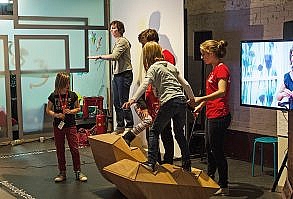Lev Vygotsky’s studies provide a basis for cognitive development. The most famous one is known as the sociocultural theory in which human development is seen as a socially mediated process where individuals get their cultural codes and problem-solving techniques via collaboration with more knowledgeable people. The theory revolves around the concepts such as the Zone of proximal development.
Vygotsky underlines the importance of social interaction for human beings since he stresses that society is central to the process of meaningful learning.
In contrast to Piaget, Vygotsky emphasized that social learning precedes development. That is why; he thinks there is a strong need for cultural and social context. Additionally, thought and language are initially separate systems from the beginning of life, merging at around three years of age. Cognitive development results from an internalization of language. Furthermore, adults transmit their culture’s tools of intellectual adaptation that children internalize. In contrast, Piaget emphasizes the importance of peers, as peer interaction promotes social perspective taking.
More Knowledgeable Other
The term “more knowledgeable other” is self-explanatory; it indicates to those who have a greater understanding or competence degree than the learner about a given activity, procedure, or topic.
Although the MKO seems to be an instructor or an older person, this is not always the case. Usually, the people with greater expertise or experience are a child’s classmates. Indeed, the MKO does not have to be a human being. To assist workers in their learning process, several businesses are increasingly using computerized performance support systems. Additionally, digital mentors have been employed in educational settings to assist and guide learners during the learning experience.
Zone of Proximal Development
“the distance between the actual developmental level as determined by independent problem solving and the level of potential development as determined through problem-solving under adult guidance, or in collaboration with more capable peers” (Vygotsky, 1978, p. 86).”
The idea of the More Knowledgeable Other is inextricably linked to Vygotsky’s second key premise, the Zone of Proximal Development. This is a critical distinction between what a youngster can do individually and what he can accomplish with the supervision and support of a trained partner.
According to Vygotsky (1978), the Zone of Proximal Development is the region in which the most delicate teaching or direction should be provided – enabling the kid to build abilities that they will subsequently utilize independently – so developing higher mental processes.
Additionally, Vygotsky considers peer interaction as a useful method of acquiring skills and tactics. He proposes that instructors use cooperative learning tasks in which less capable youngsters progress with the assistance of more capable classmates – within the zone of proximal development.

Scaffolding
The ZPD has become associated with the word scaffolding in the literature. It is essential to keep in mind, however, that Vygotsky hasn’t ever used the phrase in his writings; it was coined by Wood, Bruner, and Ross (1976).
Scaffolding is a term that refers to the exercises that an instructor or much more competent peer does to assist the student as he or she progresses through the zone of proximal development.
Similar to how a scaffold is eliminated from a structure during development, support is dropped down (i.e. withdrawn) when it becomes redundant. After that, the pupil will be able to finish the work alone.
Educational Applications
According to Vygotsky, education’s purpose is to present experiences that correspond to their ZPD, therefore supporting and furthering their unique learning. Dixon-Kraus (1966) emphasizes that “from a Vygotskian perspective, the teacher’s role is mediating the child’s learning activity as they share knowledge through social interaction” (p. 18). Scaffolding is a critical component of successful teaching, in which the adult continuously modifies the degree of assistance provided in response to the learner’s level of performance. Scaffolding may take the form of modeling a competence, offering clues or signals, and altering content or activities in the classroom.
References
Dixon-Krauss, L. (1996). Vygotsky in the classroom. Mediated literacy instruction and assessment. White Plains, NY: Longman Publishers.
Vygotsky, L. S. (1978). Mind in society: The development of higher psychological processes. Cambridge, MA: Harvard University Press.
Wood, D., Bruner, J., & Ross, G. (1976). The role of tutoring in problem-solving. Journal of Child Psychology and Child Psychiatry, 17, 89−100.
Please feel free to contact me if you need any further information





